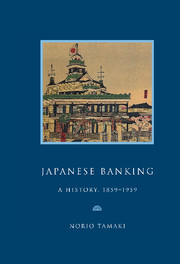Book contents
- Frontmatter
- Contents
- Preface
- Genealogy of leading Japanese banks, 1859–1959
- List of abbreviations
- Map
- Part I A bankrupt Shogunate, 1859–1868
- Part II The Meiji Restoration: monetary confusion and banking experiments, 1868–1881
- Part III Matsukata, the wizard of Japanese banking, 1881–1897; the Yokohama Specie Bank (1880) and the Bank of Japan (1882)
- Historical background
- 9 The Bank of Japan, or Nichigin, 1881–1897
- 10 The Yokohama Specie Bank, or Shokin, 1882–1897
- 11 Consolidation and expansion, 1883–1897
- 12 The adoption of the gold standard, 1893–1897
- Part IV The Japanese on the London money market, 1897–1911
- Part V War, the Japanese boom years, 1911–1919
- Part VI Crisis and the road to war, 1919–1937
- Part VII Complete commitment, struggle and defeat, 1937–1945
- Part VIII American ‘democratisation’ and the search for growth, 1945–1959
- An extraordinary century, 1859–1959
- Appendices
- Notes
- Bibliography
- Index
11 - Consolidation and expansion, 1883–1897
Published online by Cambridge University Press: 03 February 2010
- Frontmatter
- Contents
- Preface
- Genealogy of leading Japanese banks, 1859–1959
- List of abbreviations
- Map
- Part I A bankrupt Shogunate, 1859–1868
- Part II The Meiji Restoration: monetary confusion and banking experiments, 1868–1881
- Part III Matsukata, the wizard of Japanese banking, 1881–1897; the Yokohama Specie Bank (1880) and the Bank of Japan (1882)
- Historical background
- 9 The Bank of Japan, or Nichigin, 1881–1897
- 10 The Yokohama Specie Bank, or Shokin, 1882–1897
- 11 Consolidation and expansion, 1883–1897
- 12 The adoption of the gold standard, 1893–1897
- Part IV The Japanese on the London money market, 1897–1911
- Part V War, the Japanese boom years, 1911–1919
- Part VI Crisis and the road to war, 1919–1937
- Part VII Complete commitment, struggle and defeat, 1937–1945
- Part VIII American ‘democratisation’ and the search for growth, 1945–1959
- An extraordinary century, 1859–1959
- Appendices
- Notes
- Bibliography
- Index
Summary
The liquidation of the national banks and the development of ordinary banking, 1883–1896
The revisions of the National Bank Decree in 1876 had fundamentally changed the raison d'être of national banks, but the battle against hyperinflation, by redeeming government paper money, was already lost. Therefore the revised Decree merely exacerbated the problem because the notes of the national banks were additional to other governmental notes and inflation was further aggravated. In contrast, the successful launch of the Bank of Japan, under the leadership of Matsukata, had convinced the financial authorities that convertible banknotes would come to dominate the circulation. These factors combined to persuade the Finance Ministry to make fundamental changes in the way in which the national banks operated.
The first step was to revise once again the National Bank Decree in 1883 so that the national banks would be able to adapt themselves to the new circumstances. To Article 12 in the National Bank Decree, which stipulated the need to renew the licence after twenty years, a clause was added, saying:
The bank's licence will only be renewed if the bank gives up the privilege of note issue. The bank will then continue as a private bank.
This important change required a national banknote redemption procedure, which, as already discussed, was to be conducted through the Bank of Japan accounts specially opened for this purpose. The Finance Ministry simultaneously took this opportunity of reinforcing their powers in order to keep a watchful eye on the management and business of the national banks as they were transformed.
- Type
- Chapter
- Information
- Japanese BankingA History, 1859–1959, pp. 74 - 81Publisher: Cambridge University PressPrint publication year: 1995



